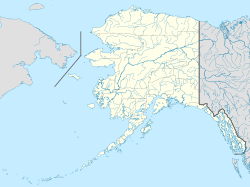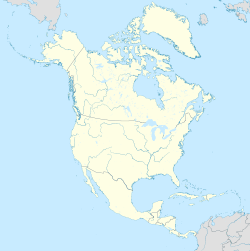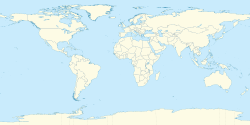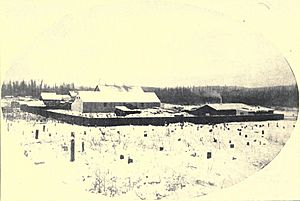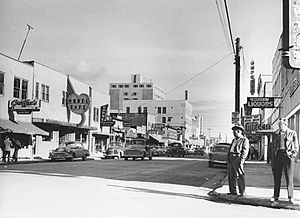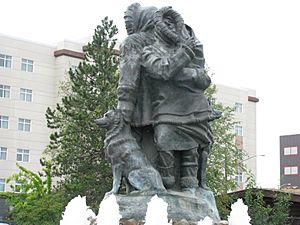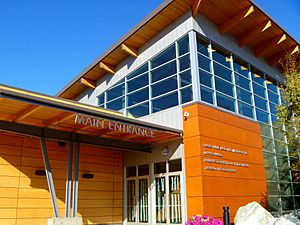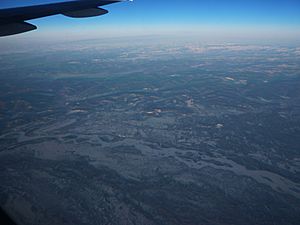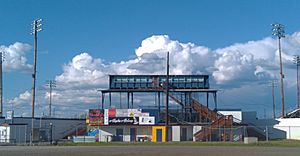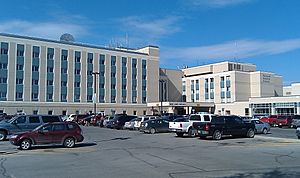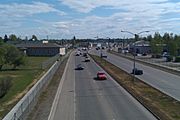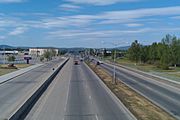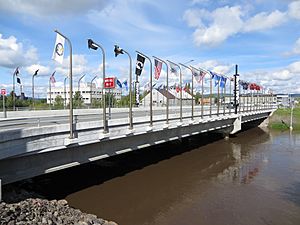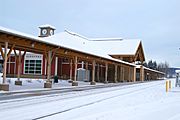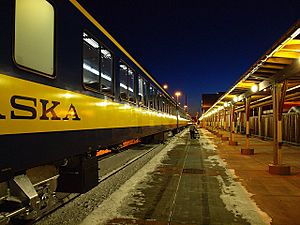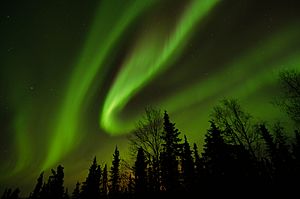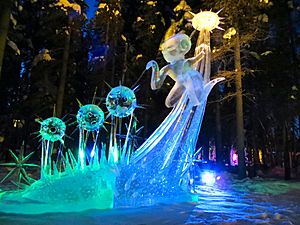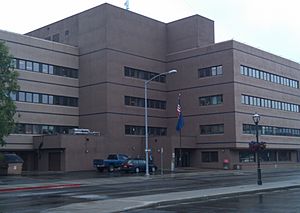Fairbanks, Alaska facts for kids
Quick facts for kids
Fairbanks, Alaska
Trothttheet (Lower Tanana)
|
||
|---|---|---|
| City of Fairbanks | ||
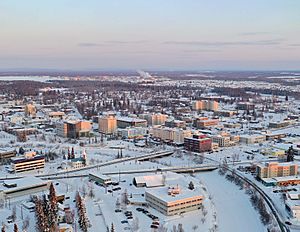
Downtown Fairbanks in 2020
|
||
|
||
| Motto(s):
The Golden Heart of Alaska
|
||
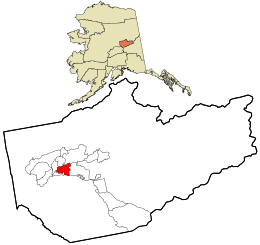
Location within Fairbanks North Star Borough and the U.S. state of Alaska
|
||
| Country | United States | |
| State | Alaska | |
| Borough | Fairbanks North Star | |
| Incorporated | November 10, 1903 | |
| Named for | Charles W. Fairbanks | |
| Government | ||
| • Type | Home rule city | |
| Area | ||
| • City | 32.62 sq mi (84.49 km2) | |
| • Land | 31.75 sq mi (82.22 km2) | |
| • Water | 0.88 sq mi (2.27 km2) | |
| Elevation | 446 ft (136 m) | |
| Population
(2020)
|
||
| • City | 32,515 | |
| • Density | 1,024.22/sq mi (395.46/km2) | |
| • Urban | 51,926 | |
| • Metro | 100,605 | |
| Demonym(s) | Fairbanksan | |
| Time zone | UTC−9 (AKST) | |
| • Summer (DST) | UTC−8 (AKDT) | |
| ZIP Codes |
99701, 99702, 99703, 99705, 99706, 99707, 99708, 99709, 99710, 99711, 99712, 99714, 99716, 99725 (Ester), 99767, 99775-(UAF), 99790
|
|
| Area code | 907 | |
| FIPS code | 02-24230 | |
| GNIS ID | 1401958 | |
Fairbanks is a home rule city and the borough seat of the Fairbanks North Star Borough in the U.S. state of Alaska.
Fairbanks is the largest and coldest city in the Interior region of Alaska and the second largest in the state. The 2020 Census put the population of the city proper at 32,515, and the population of the Fairbanks North Star Borough at 95,655 making it the second most populous metropolitan area in Alaska after Anchorage. The Metropolitan Statistical Area encompasses all of the Fairbanks North Star Borough and is the northernmost Metropolitan Statistical Area in the United States, located 196 miles (315 kilometers) by road (140 mi or 230 km by air) south of the Arctic Circle.
Fairbanks is home to the University of Alaska Fairbanks, the founding campus of the University of Alaska system.
Contents
History
Captain E. T. Barnette founded Fairbanks in August 1901 while headed to Tanacross (or Tanana Crossing, where the Valdez–Eagle trail crossed the Tanana River), where he intended to set up a trading post. The steamboat on which Barnette was a passenger, the Lavelle Young, ran aground while attempting to negotiate shallow water. Barnette, along with his party and supplies, were deposited along the banks of the Chena River 7 miles (11 km) upstream from its confluence with the Tanana River. The sight of smoke from the steamer's engines caught the attention of gold prospectors working in the hills to the north, most notably an Italian immigrant named Felice Pedroni (better known as Felix Pedro) and his partner Tom Gilmore. The two met Barnette where he disembarked and convinced him of the potential of the area. Barnette set up his trading post at the site, still intending to eventually make it to Tanacross. Teams of gold prospectors soon congregated in and around the newly founded Fairbanks; they built drift mines, dredges, and lode mines in addition to panning and sluicing.
After some urging by James Wickersham, who later moved the seat of the Third Division court from Eagle to Fairbanks, the settlement was named after Charles W. Fairbanks, a Republican senator from Indiana and later the twenty-sixth Vice President of the United States, serving under Theodore Roosevelt during his second term.
In these early years of settlement, the Tanana Valley was an important agricultural center for Alaska until the establishment of the Matanuska Valley Colonization Project and the town of Palmer in 1935. Agricultural activity still occurs today in the Tanana Valley, but mostly to the southeast of Fairbanks in the communities of Salcha and Delta Junction. During the early days of Fairbanks, its vicinity was a major producer of agricultural goods. What is now the northern reaches of South Fairbanks was originally the farm of Paul J. Rickert, who came from nearby Chena in 1904 and operated a large farm until his death in 1938. Farmers Loop Road and Badger Road, loop roads north and east (respectively) of Fairbanks, were also home to major farming activity. Badger Road is named for Harry Markley Badger, an early resident of Fairbanks who later established a farm along the road and became known as "the Strawberry King". Ballaine and McGrath Roads, side roads of Farmers Loop Road, were also named for prominent local farmers, whose farms were located in the immediate vicinity of their respective namesake roads. Despite early efforts by the Alaska Loyal League, the Tanana Valley Agriculture Association and William Fentress Thompson, the editor-publisher of the Fairbanks Daily News-Miner, to encourage food production, agriculture in the area was never able to fully support the population, although it came close in the 1920s.
The construction of Ladd Army Airfield starting in 1939, part of a larger effort by the federal government during the New Deal and World War II to install major infrastructure in the territory for the first time, fostered an economic and population boom in Fairbanks which extended beyond the end of the war. The Haines - Fairbanks 626 mile long 8" petroleum products pipeline was constructed during the period 1953-55. The presence of the U.S. military has remained strong in Fairbanks. Ladd became Fort Wainwright in 1960; the post was annexed into Fairbanks city limits during the 1980s.
Fairbanks suffered from numerous floods in its first six decades, whether from ice jams during spring breakup or due to heavy rainfall. The first bridge crossing the Chena River, a wooden structure built in 1904 to extend Turner Street northward to connect with the wagon roads leading to the gold mining camps, washed out with regularity before a permanent bridge was constructed at Cushman Street in 1917 by the Alaska Road Commission. On August 14, 1967, after record rainfall upstream, the Chena began to surge over its banks, flooding almost the entire town of Fairbanks overnight. The results of this disaster eventually led to the creation of the Chena River Lakes Flood Control Project, which built and operates the 50-foot-high (15 m) Moose Creek Dam in the Chena River and accompanying 8-mile-long (13 km) spillway. The project was designed to prevent a repetition of the 1967 flood by being able to divert water in the Chena upstream from Fairbanks into the Tanana River, thus bypassing the city.
Topography
Fairbanks is located in the central Tanana Valley, straddling the Chena River near its confluence with the Tanana River. Immediately north of the city is a chain of hills that rises gradually until it reaches the White Mountains and the Yukon River. The southern border of the city is the Tanana River. South of the river is the Tanana Flats, an area of marsh and bog that stretches for more than 100 miles (160 km) until it rises into the Alaska Range, which is visible from Fairbanks on clear days. To the east and west are low valleys separated by ridges of hills up to 3,000 feet (910 m) above sea level.
The Tanana Valley is crossed by many low streams and rivers that flow into the Tanana River. In Fairbanks, the Chena River flows southwest until it empties into the Tanana. Noyes Slough, which heads and foots off the Chena River, creates Garden Island, a district connected to the rest of Fairbanks by bridges and culverted roads.
According to the United States Census Bureau, the city has a total area of 32.7 square miles (85 km2); 31.9 square miles (83 km2) of it is land and 0.8 square miles (2.1 km2) of it (2.48%) is water.
Location
The city is extremely far north, being located close to 16 parallels north of the Pacific border between the U.S. and Canada. It is roughly on the same parallel as northern Swedish city of Skellefteå and Finnish city of Oulu. Apart from those cities, this parallel is sparsely populated due to its cold climate. On account of its warm summers, however, Fairbanks is located south of the arctic tree line.
 |
College | Farmers Loop Steele Creek |
Badger Steele Creek |
 |
| College | Badger | |||
| South Van Horn | South Van Horn | Badger |
Climate
Fairbanks' climate is classified as subarctic (Köppen Dfc), with long, very cold winters, and short, warm summers, in which much of the annual precipitation falls. In Fairbanks, winter lasts from mid-October until mid to late April. October through January are the snowiest, and snow is limited from February to May. On average, the season's first snow falls in Fairbanks on September 21, the first inch of snow accumulates by October 8 and the last inch of snow falls on April 27. The last flurries happen in April on average, but it occasionally does flurry in May. The snowpack is established by October 18, on average, and remains until April 23. Snow occasionally arrives early and in large amounts. On September 13, 1992, 8 inches (20 cm) of snow fell in the city, bending trees still laden with fall leaves. That September was also one of the snowiest on record, as 24 in (61 cm) fell, compared to a median of only 0.3 in (0.8 cm) in the month. The average first and last hard freeze are September 9 and May 15, respectively, allowing a growing season of 116 days, although freezes have occurred in June, July, and August and the last light frost is often in early June and the first light fall frost is often in late August or early September. October and November are the snowiest months, but in contrast, March and April are not very snowy, not because of the relative warmth but the fact that those are typically very dry months in central Alaska. In spite of its very cold winters and often cool summers, Fairbanks is not far below being a semi-arid influenced humid continental climate, with only the cool May nights hindering this classification.
Fairbanks is commonly known as America's coldest city. Average winter low temperatures range from −15 to −25 °F (−26 to −32 °C), but extremes can range from −60 to −75 °F (−51 to −59 °C). In summer, temperatures typically range between 70 and 50 °F (21 and 10 °C). Between 1994 and 2009, Fairbanks recorded a temperature of 90 °F (32 °C). The highest recorded temperature in Fairbanks was 99 °F (37 °C) on July 28, 1919; this is just 1 °F (0.6 °C) shy of the record high temperature for Alaska which is 100 °F (38 °C), recorded in Fort Yukon. The lowest was −66 °F (−54 °C) on January 14, 1934. The warmest year in Fairbanks was 1981, when the average annual temperature was 32.0 °F (0.0 °C), while the coldest year was 1956 with an annual mean temperature of 21.3 °F (−5.9 °C). Low temperatures below 0 °F (−18 °C) have been recorded in every month outside June through September. The record cold daily maximum is −58 °F (−50 °C) on January 18, 1906, and the record warm daily minimum is 76 °F (24 °C) on June 26, 1915; the only other occurrence of a 70 °F (21 °C) daily minimum was June 25, 2013 in the midst of a particularly warm summer.
These widely varying temperature extremes are due to three main factors: temperature inversions, daylight, and wind direction. In winter, Fairbanks' low-lying location at the bottom of the Tanana Valley causes cold air to accumulate in and around the city. Warmer air rises to the tops of the hills north of Fairbanks, while the city itself experiences one of the biggest temperature inversions on Earth. Heating through sunlight is limited because of Fairbanks's high-latitude location. At the winter solstice, the center of the sun's disk is less than two degrees over the horizon (1.7 degrees) at the local noon (not the time zone noon). Fairbanks experiences 3 hours and 41 minutes of sunlight on December 21 and 22. At the summer solstice, about 182 days later, on June 20 and 21, Fairbanks receives 21 hours and 49 minutes of sunlight. After sunset, twilight is bright enough to allow daytime activities without any artificial lights. During winter, the direction of the wind also causes large temperature swings in Fairbanks. When the wind blows from any direction but the south, average weather ensues. Wind from the south can carry warm, moist air from the Gulf of Alaska, greatly warming temperatures. When coupled with a chinook wind, temperatures well above freezing often result.
In addition to the chinook wind, Fairbanks experiences a handful of other unusual meteorological conditions. In summer, dense wildfire smoke accumulates in the Tanana Valley, affecting the weather and causing health concerns. When temperature inversions arise in winter, heavy ice fog often results. Ice fog occurs when air is too cold to absorb additional moisture, such as that released by automobile engines or human breath. Instead of dissipating, the water freezes into microscopic crystals that are suspended in the air, forming fog. Another one of Fairbanks' unusual occurrences is the prevalence of the aurora borealis, commonly called the northern lights, which are visible on average more than 200 days per year in the vicinity of Fairbanks.
Since 1949, Fairbanks's average winter temperature has risen by 6.9 °F (3.8 °C), average spring temperature by 3.9 °F (2.2 °C), and its average summer temperature by 2.3 °F (1.3 °C). During the same period, however, the average autumn temperature has only risen by 0.1 °F (0.056 °C). If only the years 1977–2012 are considered, Fairbanks' average annual temperature has dropped by 1.7 °F (0.94 °C).
| Climate data for Fairbanks International Airport, Alaska (1981–2010 normals, extremes 1904–present) | |||||||||||||
|---|---|---|---|---|---|---|---|---|---|---|---|---|---|
| Month | Jan | Feb | Mar | Apr | May | Jun | Jul | Aug | Sep | Oct | Nov | Dec | Year |
| Record high °F (°C) | 52 (11) |
50 (10) |
56 (13) |
76 (24) |
90 (32) |
96 (36) |
99 (37) |
93 (34) |
84 (29) |
72 (22) |
54 (12) |
58 (14) |
99 (37) |
| Mean maximum °F (°C) | 29.7 (−1.3) |
35.2 (1.8) |
44.7 (7.1) |
61.8 (16.6) |
75.6 (24.2) |
84.9 (29.4) |
85.1 (29.5) |
80.2 (26.8) |
68.2 (20.1) |
52.6 (11.4) |
32.4 (0.2) |
32.2 (0.1) |
87.3 (30.7) |
| Average high °F (°C) | 1.1 (−17.2) |
10.0 (−12.2) |
25.4 (−3.7) |
44.5 (6.9) |
61.0 (16.1) |
71.6 (22.0) |
72.7 (22.6) |
65.9 (18.8) |
54.6 (12.6) |
31.9 (−0.1) |
10.9 (−11.7) |
4.8 (−15.1) |
38.0 (3.3) |
| Daily mean °F (°C) | −7.9 (−22.2) |
−1.3 (−18.5) |
11.4 (−11.4) |
32.5 (0.3) |
49.4 (9.7) |
60.4 (15.8) |
62.5 (16.9) |
56.1 (13.4) |
44.9 (7.2) |
24.2 (−4.3) |
2.6 (−16.3) |
−4.1 (−20.1) |
27.6 (−2.4) |
| Average low °F (°C) | −16.9 (−27.2) |
−12.7 (−24.8) |
−2.5 (−19.2) |
20.6 (−6.3) |
37.8 (3.2) |
49.3 (9.6) |
52.3 (11.3) |
46.4 (8.0) |
35.1 (1.7) |
16.5 (−8.6) |
−5.7 (−20.9) |
−12.9 (−24.9) |
17.4 (−8.1) |
| Mean minimum °F (°C) | −41.3 (−40.7) |
−36.2 (−37.9) |
−24.4 (−31.3) |
−2.8 (−19.3) |
26.8 (−2.9) |
39.6 (4.2) |
44.4 (6.9) |
35.1 (1.7) |
22.5 (−5.3) |
−5.6 (−20.9) |
−26.7 (−32.6) |
−37.2 (−38.4) |
−45.9 (−43.3) |
| Record low °F (°C) | −66 (−54) |
−58 (−50) |
−56 (−49) |
−32 (−36) |
−1 (−18) |
27 (−3) |
30 (−1) |
19 (−7) |
3 (−16) |
−27 (−33) |
−54 (−48) |
−62 (−52) |
−66 (−54) |
| Average precipitation inches (mm) | 0.58 (15) |
0.42 (11) |
0.25 (6.4) |
0.31 (7.9) |
0.60 (15) |
1.37 (35) |
2.16 (55) |
1.88 (48) |
1.10 (28) |
0.83 (21) |
0.67 (17) |
0.64 (16) |
10.81 (275) |
| Average snowfall inches (cm) | 10.3 (26) |
8.1 (21) |
4.9 (12) |
2.9 (7.4) |
0.9 (2.3) |
trace | 0 (0) |
trace | 1.8 (4.6) |
10.8 (27) |
13.2 (34) |
12.1 (31) |
65.0 (165) |
| Average precipitation days (≥ 0.01 in) | 8.5 | 6.6 | 4.8 | 3.6 | 7.1 | 10.9 | 12.9 | 13.3 | 10.4 | 11.2 | 10.3 | 9.0 | 108.6 |
| Average snowy days (≥ 0.1 in) | 10.1 | 7.9 | 5.9 | 2.8 | 0.8 | 0 | 0 | 0 | 1.4 | 10.2 | 11.9 | 10.8 | 61.8 |
| Average relative humidity (%) | 69.3 | 65.5 | 60.4 | 56.2 | 50.2 | 56.6 | 64.2 | 70.8 | 68.9 | 74.1 | 72.8 | 71.3 | 65.0 |
| Mean monthly sunshine hours | 54 | 120 | 224 | 302 | 319 | 334 | 274 | 164 | 122 | 85 | 71 | 36 | 2,105 |
| Source 1: NOAA (relative humidity 1961–1990) | |||||||||||||
| Source 2: Danish Meteorological Institute (sun, 1931–1960) | |||||||||||||
People and culture
Demographics
| Historical population | |||
|---|---|---|---|
| Census | Pop. | %± | |
| 1910 | 3,541 | — | |
| 1920 | 1,155 | −67.4% | |
| 1930 | 2,101 | 81.9% | |
| 1940 | 3,455 | 64.4% | |
| 1950 | 5,771 | 67.0% | |
| 1960 | 13,311 | 130.7% | |
| 1970 | 14,711 | 10.5% | |
| 1980 | 22,645 | 53.9% | |
| 1990 | 30,843 | 36.2% | |
| 2000 | 30,224 | −2.0% | |
| 2010 | 31,535 | 4.3% | |
| 2015 (est.) | 32,325 | 2.5% | |
|
|
|||
The U.S. census Bureau estimates that the population of 2011 in the city was 32,036 people, 11,075 households, and 7,187 families residing in the city. The population density was 995 people per square mile (366.3/km²). There were 12,357 housing units at an average density of 387.9 per square mile (149.8/km²). The racial makeup of the city was 66.1% White, 9.0% Black or African-American, 10.0% Native American, 3.6% Asian, 0.8% Pacific Islander. In addition, 9.0% of the population identified as Hispanic or Latino. The population estimate for the Fairbanks North Star Borough was 99,192. The racial makeup of the North Star Borough was 78.2% White, 5.0% Black, 7.2% Native American, 2.8% Asian, 0.4% Pacific Islander; 6.3% identified as Hispanic or Latino.
Of the 11,075 households, 39.9% had children under the age of 18, 47.2% were married couples living together, 12.6% had a female householder with no husband present, and 35.1% were non-families. 27.4% of all households were made up of individuals and 6.0% had someone living alone who was 65 years of age or older. The average household size was 2.56 and the average family size was 3.15.
Median age of the population was 28 years, with 9.6% under the age of 5, 26.0% under the age of 18, 14.7% from 18 to 24, 32.8% from 25 to 44, 16.4% from 45 to 64, and 7.3% who were 65 years of age or older. For every 100 females there were 105.3 males. For every 100 females age 18 and over, there were 108.2 males.
The median income for a household between 2007 and 2011 was $55,409. Males had a median income of $30,539 versus $26,577 for females. The per capita income for the city was $19,814. About 7.4% of families and 10.5% of the population were below the poverty line, including 11.6% of those under age 18 and 7.0% of those age 65 or over. The percentage of high school graduates or higher is 88%. 20.4% of the population 25 years and up had a bachelor's degree or higher.
Media
Fairbanks' largest newspaper is the Fairbanks Daily News-Miner, which also includes a weekly entertainment guide, Latitude 65. A few other periodicals also serve Fairbanks and the Fairbanks North Star Borough: The Ester Republic and the University of Alaska Fairbanks student newspaper, the Sun Star.
Fairbanks is also served by television and radio. Leading radio stations include AM Stations KFAR 660 talk radio, KCBF 820 ESPN Radio Network, KFBX 970 talk radio and KJNP 1170 religious radio. FM stations include 88.3 popular Christian, KUAC 89.9 National Public Radio, KSUA 91.5 University of Alaska, Fairbanks, KDJF ("CHET FM") 93.5 everything country KXLR 94.3 Alaska's new country KWDD 95.9 classic rock KYSC 96.9 soft rock, KWLF 98.1-"Wolf 98.1", top 40, KJNP-FM 100.3 religious radio, KAKQ-FM 101.1-"Magic 101.1" pop music, KIAK-FM 102.5 country music, KTDZ 103.9-"K-TED" adult hits, KKED 104.7 rock music, and KDFJ-LP 105.9 religious radio.
Fairbanks' major television affiliates are KATN (ABC)-(KYUR retransmission), KFXF (Fox), KUAC-TV (PBS)-"AlaskaONE" with some KMXT-LP-only programming, KTVF (NBC), KXDF-CD (CBS), and UHF station KDMD-LP-(Ion)-Fairbanks. Cable TV is available from GCI.
Sports
Fairbanks hosted the 2014 Arctic Winter Games from March 15–22, 2014.
The Carlson Center is home to University of Alaska Fairbanks Nanooks men's ice hockey.
The Fairbanks Ice Dogs, a junior hockey team in the North American Hockey League, play at the Big Dipper Ice Arena. Prior to the formation of the Ice Dogs, the Fairbanks Gold Kings was formed as a league team by the Teamsters Local 959 in 1974. The team took on a life of its own beyond local league play, and played out of the Big Dipper for many years until moving to Colorado Springs, Colorado (becoming the Colorado Gold Kings) in 1998.
The Alaska Goldpanners and the Fairbanks AIA Fire are summer collegiate baseball teams, playing home games at Growden Memorial Park. The park is home to the annual Midnight Sun Game, an annual tradition since 1906, played without artificial lights starting after ten at night on the summer solstice.
The city was briefly represented in the Indoor Football League by the Fairbanks Grizzlies.
Also, Fairbanks is a hub for cross-country skiing in Alaska. It has hosted many different big ski events including the 2003 Junior Olympic Cross Country Ski Championship and the 2008 and 2009 U.S. Cross Country Distance Nationals It also has an annual 50k race called the Sonot Kkaazoot and the Fairbanks Town Series races which consists of four different races and the Chest Medicine Distance Series races which consists of only 3 races.
Fairbanks is also home to the Yukon Quest, an international 1,000 mile sled dog race that is considered one of the toughest in the world. The race alternates its starting and finishing points each year between Fairbanks, Alaska and Whitehorse, Yukon.
Notable people
Fairbanks, Alaska was the birthplace of a significant number of successful musicians. Some distinguished individuals are Kelly Moneymaker, Kevin Johansen, Kevin Lenear of The Mighty Mighty Bosstones, Vivica Genaux, Lincoln Brewster, Rick Holmstrom, John Luther Adams, and Jon Button.
Susan Butcher, four time Iditarod winner, and husband David Monson, winner of the Yukon Quest, lived in Fairbanks. After Susan's death David kept on running their dog farm, Trail Breaker Kennels.
Lance Mackey, four-time winner of the grueling, world-famous Yukon Quest and Iditarod sled dog races, lives in the Fairbanks area.
Fairbanks was also the starting place for Daryn Colledge, an offensive guard for the Arizona Cardinals. Colledge played for the Green Bay Packers and helped the team gain their victory in Super Bowl XLV.
Jessica Gavora is a conservative writer on culture and politics. She was the chief speechwriter for Attorney General John Ashcroft and a senior policy advisor at the Department of Justice.
The late John Drury Clark was born and raised in Fairbanks. He became a noted American rocket fuel developer, science fiction writer, and chemist.
The late Bob Ross, artist and host of The Joy of Painting on PBS, made his home in Fairbanks.
Facilities and services
Utilities
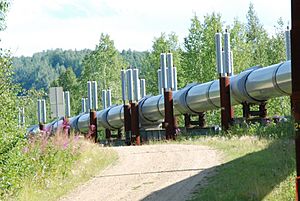
Electricity is provided by the Golden Valley Electric Association. The Chena power site has four steam turbines fueled by coal and one oil-fueled electrical generator. Interior Alaska is not connected to the electrical grid of the contiguous United States and Canada, but a transmission line constructed in 1985 connects Fairbanks with power plants in the coal producing area of Healy and the Anchorage area. Fairbanks currently holds the world record for the largest rechargeable battery, which weighs approximately 1,300 tons. The battery was installed to help bridge the gaps that occur during frequent power outages. The battery will provide power for 7 minutes to about 12,000 homes.
The University of Alaska Fairbanks operates its own coal-fired generating station on campus, providing electricity and steam heat to university buildings.
Until 1996, telephone service was provided by the Municipal Utilities Service, a public company. In that year, telephone service was sold to Alaska Communications Systems, a private company. General Communications Inc. has competed against ACS in Fairbanks since 1997. Both companies offer mobile phone service in Fairbanks, as do national and local providers such as AT&T Mobility and Verizon Wireless.
A pair of fiber optic cables provide long-distance telephone and Internet service. One parallels the Parks Highway and connects Fairbanks to Anchorage, while the other parallels the Richardson Highway and connects Fairbanks to Valdez. A third, spur fiber optic cable parallels the Trans-Alaska Pipeline and connects Fairbanks to Prudhoe Bay. Broadband Internet access is provided by GCI, ACS, Ace Tekk and a handful of satellite Internet and wireless Internet services.
Transportation
As the transportation hub for Interior Alaska, Fairbanks features extensive road, rail, and air connections to the rest of Alaska and Outside. At Fairbanks' founding, the only way to reach the new city was via steamboat on the Chena River. In 1904, money intended to improve the Valdez-Eagle Trail was diverted to build a branch trail, giving Fairbanks its first overland connection to the outside world. The resulting Richardson Highway was created in 1910 after Gen. Wilds P. Richardson upgraded it to a wagon road. In the 1920s, it was improved further and made navigable by automobiles, but it was not paved until 1957.
Fairbanks' road connections were improved in 1927, when the 161-mile (259 km) Steese Highway connected the city to the Yukon River at the gold-mining community of Circle. In 1942, the Alaska Highway connected the Richardson Highway to the Canadian road system, allowing road travel from the rest of the United States to Fairbanks, which is considered the unofficial end of the highway. Because of World War II, civilian traffic was not permitted on the highway until 1948.
In the late 1960s and early 1970s, a series of roads were built to connect Fairbanks to the oil fields of Prudhoe Bay. The Elliott Highway was built in 1957 to connect Fairbanks to Livengood, southern terminus of the Dalton Highway, which ends in Deadhorse on the North Slope. West of the Dalton intersection, the Elliott Highway extends to Manley Hot Springs on the Tanana River. To improve logistics in Fairbanks during construction of the Trans-Alaska Pipeline, the George Parks Highway was built between Fairbanks and Palmer in 1971.
Until 1940, none of Fairbanks' surface streets were paved. The outbreak of World War II interrupted plans to pave most of the city's roads, and a movement toward large-scale paving did not begin until 1953, when the city paved 30 blocks of streets. During the late 1950s and the 1960s, the remainder of the city's streets were converted from gravel roads to asphalt surfaces. Few have been repaved since that time; a 2008 survey of city streets indicated the average age of a street in Fairbanks was 31 years.
Public transportation has been provided by the Metropolitan Area Commuter System, an agency of the borough government, since 1977. Bus service links much of the urban Fairbanks area, with most routes connecting at the downtown transit center. University Bus Lines, a private company, existed for several decades before MACS started. The company, which was owned first by Paul Greimann and later by Walt Conant, mainly linked downtown Fairbanks with the university campus and the military bases.
Air Transport
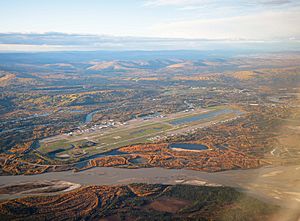
Fairbanks International Airport serves as a major hub for Alaska air travel. Several regional and charter airlines use or have used the location as their main base of operations due to its central location in the state. Commercial airlines also connect Fairbanks to the lower 48 and select international destinations. Fairbanks is the smallest city in the United States to be served by transatlantic flights, as Condor operates direct flight to Frankfurt in the summer tourist season.
Rail transport
After large-scale gold mining began north of Fairbanks, miners wanted to build a railroad from the steamboat docks on the Chena River to the mine sites in the hills north of the city. The result was the Tanana Mines Railroad, which started operations in September 1905, using what had been the first steam locomotive in the Yukon Territory. In 1907, the railroad was reorganized and named the Tanana Valley Railroad. The railroad continued expanding until 1910, when the first gold boom began to falter and the introduction of automobiles into Fairbanks took business away from the railroad. Despite these problems, railroad backers envisioned a rail line extending from Fairbanks to Seward on the Gulf of Alaska, home to the Alaska Central Railway.
In 1914, the US Congress appropriated $35 million for construction of the Alaska Railroad system, but work was delayed by the outbreak of World War I. Three years later, the Alaska Railroad purchased the Tanana Valley Railroad, which had suffered from the wartime economic problems. Rail workers built a line extending northwest from Fairbanks, then south to Nenana, where President Warren G. Harding hammered in the ceremonial final spike in 1923. The rail yards of the Tanana Valley Railroad were converted for use by the Alaska Railroad, and Fairbanks became the northern end of the line and its second-largest depot.
From 1923 to 2004, the Alaska Railroad's Fairbanks terminal was in downtown Fairbanks, just north of the Chena River. In May 2005, the Alaska Railroad opened a new terminal northwest of downtown, and that terminal is in operation today. In summer, the railroad operates tourist trains to and from Fairbanks, and it operates occasional passenger trains throughout the year. The majority of its business through Fairbanks is freight. The railroad is planning an expansion of the rail line from Fairbanks to connect the city via rail with Delta Junction, about 100 miles (160 km) southeast.
Attractions and points of interest
The city of Fairbanks and the greater Fairbanks area is home to a number of attractions and events, which draw visitors from outside of Alaska throughout the year. Summer tourist traffic primarily consists of cruise ship passengers who purchase package tours which include travel to Fairbanks. Many of these tourists spend one or more nights at a local hotel and visit one or more attractions. Tourism the rest of the year is mostly concentrated around the winter season, centered upon the northern lights, ice carving and winter sports. In addition, other events draw visitors from within Alaska, mostly from the community's trading area throughout Interior Alaska and the North Slope.
|
|
Sister cities
Fairbanks is twinned with:
 Aix-les-Bains, Savoie, Auvergne-Rhône-Alpes, France
Aix-les-Bains, Savoie, Auvergne-Rhône-Alpes, France Erdenet, Mongolia
Erdenet, Mongolia Fanano, Modena, Emilia-Romagna, Italy
Fanano, Modena, Emilia-Romagna, Italy Mo i Rana, Norway
Mo i Rana, Norway Monbetsu, Japan (dormant)
Monbetsu, Japan (dormant) Tainan, Taiwan
Tainan, Taiwan Yakutsk, Russia
Yakutsk, Russia Richland, Washington, United States of America
Richland, Washington, United States of America Yellowknife, Northwest Territories, Canada
Yellowknife, Northwest Territories, Canada
- Hedrick, Basil and Savage, Susan. Steamboats on the Chena. Fairbanks. Epicenter Press, 1988. ASIN B000OM7YIK.
- Boswell, John. History of Alaskan Operations of United States Smelting, Refining, and Mining Company. Fairbanks. University of Alaska, Mineral Industries Research Laboratory, 1979.
- Cashen, William. Farthest North College President. Charles E. Bunnell and the Early History of the University of Alaska. Fairbanks. University of Alaska Press, 1972.
- Cloe, John and Monaghan, Michael. Top Cover for America. Missoula, Montana. Pictorial Histories Publishing Co., 1984.
- Cole, Terrence. The Cornerstone on College Hill: An Illustrated History of the University of Alaska Fairbanks. Fairbanks. University of Alaska Press, 1994.
- Cooley, Richard. Fairbanks, Alaska: A Survey of Progress. Juneau. Alaska Development Board, June 1954.
- Davis, Neil. The College Hill Chronicles: How the University of Alaska Came of Age. Fairbanks. University of Alaska Foundation, 1992.
- Dixon, Mim. What Happened to Fairbanks? The Effects of the Trans-Alaska Oil Pipeline on the Community of Fairbanks, Alaska. Boulder, Colorado. Westview Press, 1978.
- Kirchner, L. D. Flag Over the North, The Story of the Northern Commercial Company. Seattle. Superior Publishing Company, 1954.
- Kruse, John A. Fairbanks Community Survey. Fairbanks. Institute of Social and Economic Research, 1976.
- Movius, Phyllis. The Role of Women in the Founding and Development of Fairbanks, Alaska, 1903–1923. Fairbanks. University of Alaska Fairbanks, 1996.
- Naske, Claus, and Rowinski, L.J. Fairbanks: A Pictoral History. Virginia Beach, Virginia. The Donning Company, 1981.
- Patty, Ernest. North Country Challenge. New York. David McKay, 1949.
- Potter, Jean. Alaska Under Arms. New York. Macmillan, 1942.
- Potter, Jean. The Flying North. New York. Macmillan, 1947.
- Rickard, T.A. Through the Yukon and Alaska. San Francisco. Mining and Scientific Press, 1909.
- Robe, Cecil. The Penetration of an Alaskan Frontier, The Tanana Valley and Fairbanks. PhD dissertation, Yale University, 1943.
- Wickersham, James. Old Yukon. Washington, D.C. Washington Law Book Co., 1938.
- Wold, Jo Anne. This Old House. Anchorage. Alaska Northwest Publishing Co., 1976.
- Wold, Jo Anne. Fairbanks: The $200 Million Gold Rush Town. Fairbanks. Wold Press, 1971.
Economy
Among the companies based in Fairbanks are Doyon, Limited.
Taxes
- Sales: none
- Property: 20.777 mills (7.171 city/13.606 borough areawide)
- Special: 5% alcohol tax (city only); 16% tobacco tax (8% city/8% borough); 8% accommodations tax
Education
Fairbanks North Star Borough School District operates public schools serving the City of Fairbanks.
The Yukon–Koyukuk School District has its administrative headquarters in College CDP, but its schools are in the Yukon-Koyukuk area, not Fairbanks.
Notable people
- John Luther Adams (born 1953), composer whose music is inspired by nature, especially the landscapes of Alaska, where he lived from 1978 to 2014
- Lincoln Brewster (born 1971), contemporary Christian musician, worship pastor
- Susan Butcher (1954–2006), dog musher, noteworthy as the second woman to win the Iditarod Trail Sled Dog Race in 1986, the second four-time winner in 1990, and the first to win four out of five sequential years. She is commemorated in Alaska by the Susan Butcher Day
- Jon Button, bass player born in Fairbanks, Alaska, and based in Los Angeles, California
- John Drury Clark (1907–1988), born and raised in Fairbanks; noted American rocket fuel developer, science fiction writer, and chemist
- Daryn Colledge (born 1982), offensive guard for the Arizona Cardinals; played for the Green Bay Packers and helped the team gain their victory in Super Bowl XLV
- Mike Dunlap (born 1957), NBA and college basketball head coach, was born in Fairbanks
- Denali Foxx (born 1992), a.k.a. Cordero Zuckerman, drag queen, figure skater and contestant who made it to the Top 8 on the thirteenth season of RuPaul's Drag Race
- Jessica Gavora (born 1963), writer on culture and politics; chief speechwriter for Attorney General John Ashcroft and a senior policy advisor at the Department of Justice
- Vivica Genaux (born 1969), coloratura mezzo-soprano
- James C. Hayes (born 1946), mayor of Fairbanks (1992–2001), the first African-American mayor in the state of Alaska
- Ruthy Hebard (born 1998), a first-round selection of the Chicago Sky in the 2020 WNBA draft, was raised from infancy in Fairbanks, attending West Valley High School
- Rick Holmstrom (born 1965), electric blues and rhythm and blues guitarist, singer-songwriter
- Kevin Johansen (born 1964), musician, singer-songwriter
- Lance Mackey (born 1970), four-time winner of the Yukon Quest and Iditarod sled dog races, lives in the Fairbanks area
- Kelly Moneymaker (born 1970), singer, songwriter, producer
- Paul Varelans (1969–2021), MMA and UFC pioneer, fought out of Fairbanks. The city was cited as the inspiration behind his nickname, "The Polar Bear"
Images for kids
See also
 In Spanish: Fairbanks para niños
In Spanish: Fairbanks para niños



